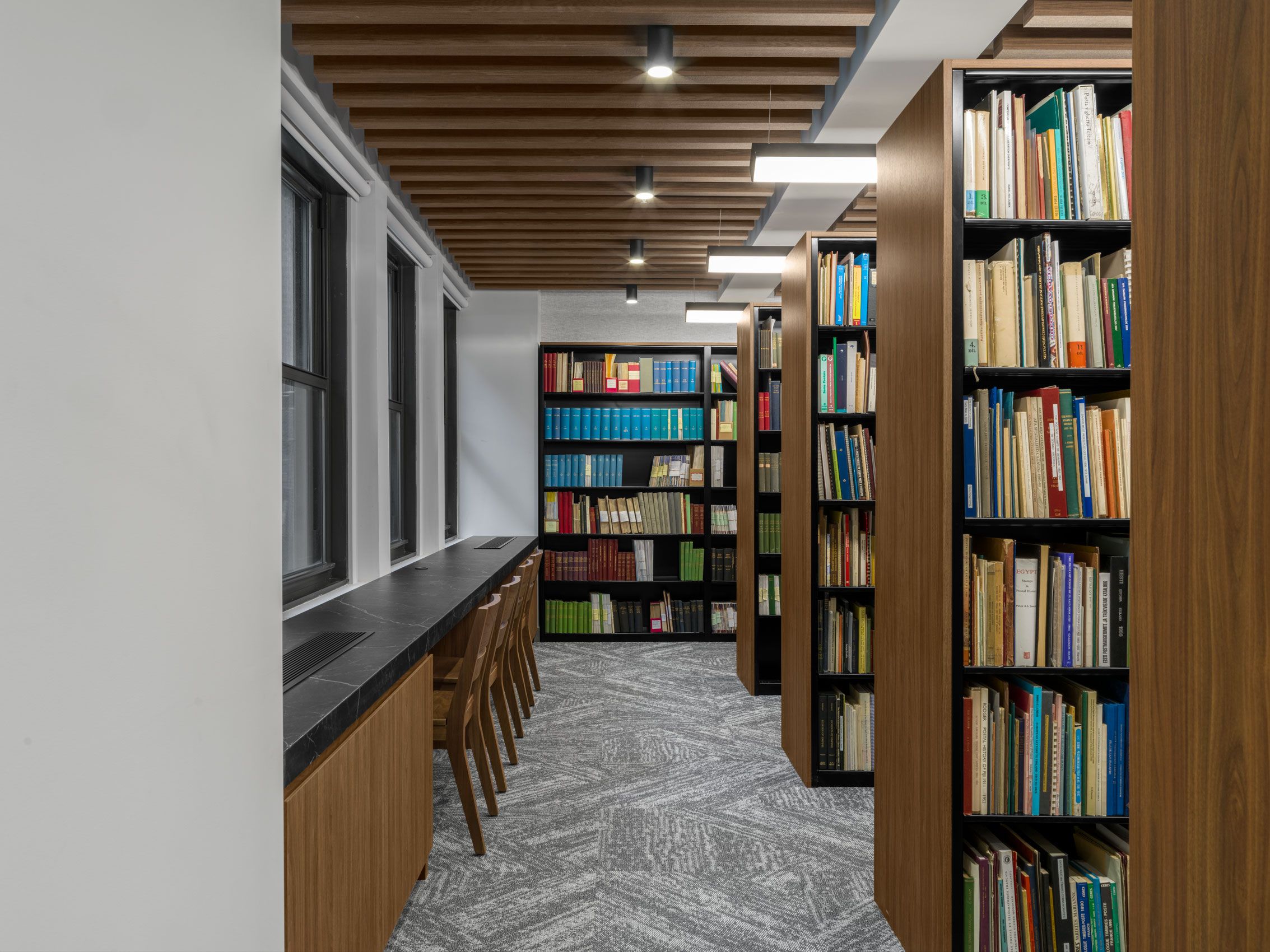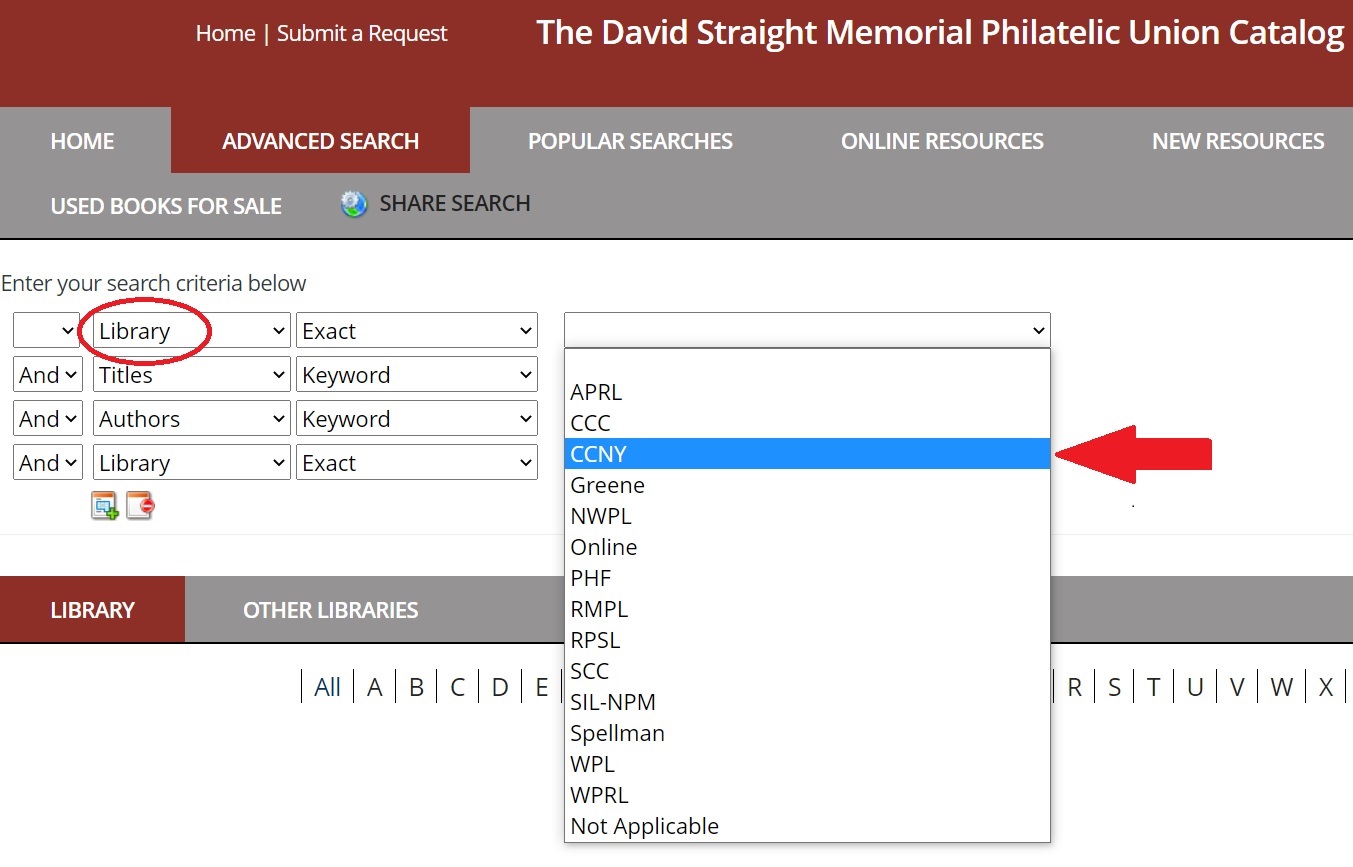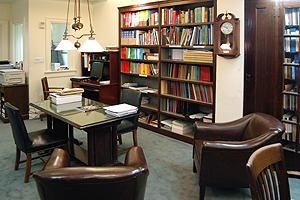
The Collectors Club is one of the most important philatelic libraries in the world. Beyond housing some of the very rare pieces in philatelic literature, it is very much a “working” library. Members and visitors can research or browse through philatelic publications, periodicals and auction catalogues. The library is open during normal Club hours, Monday through Friday from 10AM to 5PM.
Library Structure
The library is divided into four basic sections all on the same floor. These include the Open Shelves for books, the Reference and periodicals by the librarian’s desk, the journals and auction catalogs in the high-density shelving rear room, and the rare book room.
Open Shelves
As you enter the Collectors Club the library is to your left. There are a series of open shelves which primarily hold books and pamphlets. These are organized by country with the United States on the first series of bookcases. The United States books are divided by subject and within subject arranged alphabetically by author. The pattern follows the same for all other countries. The library has a long table where individuals can work alone or work as a group. It also has several individual size working areas. These all have good lighting and electrical supports for laptops and chargers.
Reference and Periodicals
Reference books and current periodicals are on shelves next to the librarian’s desk. If you note that we are lacking an important book, please let the librarian or a volunteer know.
Journals and Auction Catalogs
Beyond the book section, there are journals arranged alphabetically on the remaining open shelves and continue in the rear room on the left side of the. Historic and other important Auctions Catalogs are found left of the high-density shelves.
Rare Books
The rare book room houses some of the treasures and rarities of the library. This room can only be accessed in the presence of the librarian or club volunteer. It is located just to your left as you enter the main library area. We are always willing to provide guidance on where to find things.
The library has a long table where individuals can work or work as a group. It also has several individual size working areas. These all have good lighting and electrical supports for laptops and chargers.
For additional information or to volunteer at the library, please contact us readingroom@collectorsclub.org
Library Visitors Rules and Etiquette
Library Sign-in Register
All members and non-members using the library are required to register their names in the book provided for that purpose. The sign-in register is located on the front table of the library. Members and guests are asked to sign-in with the following information: Date, Name, Reading/Research area of interest. This provides information useful for future book and journal acquisitions.
Return Books Here Bin
All books and pamphlets taken from the shelves should not be returned to the shelves. To reduce misfiling after use, material is to be placed in the “Return Books Here Bin” located near the reference section.
Library Etiquette
Smoking and vaping are forbidden throughout the club. Food and beverages including water, are not permitted in any sections of the library. There is ample room for food and drink in the kitchen and social areas. If you note any damaged or misplaced books or other items, please bring this to the attention of a club volunteer or the librarian.
Library Services
Online Catalog
 “The easiest way to determine if a book The Collectors Club Library is a to search the Philatelic Union Catalog. This is accessed on the American Philatelic Research Library (APRL) web page: https://stamps.org/services/library
“The easiest way to determine if a book The Collectors Club Library is a to search the Philatelic Union Catalog. This is accessed on the American Philatelic Research Library (APRL) web page: https://stamps.org/services/library
Click on the “Advanced Search” tab at the top of the online catalog landing page.
Once on the “Advanced Search” page (pictured right), then chose “Library” as the search field and the select “CCNY” from drop-down selection list. As the Library committee updates and verifies our holdings, additional sections of our catalog holdings will be incorporated into the APRL’s Online Catalog.
Book Loans
Book loans are available only to members. There is no fee for borrowing a book directly from the library. To cover the costs incurred in providing these book loans through the mail, fees are:
- Base fee: $10 per shipment/request includes the first book.
- Additional books in the same request are $5 for each.
Only Members may borrow non-reference books and pamphlets from the Main Library and only for a maximum of 30 days. Material from the Rare Book Collection, Periodicals, Catalogs and Auction Catalogs may not be removed from the Library.
Scanning Services
Scanning services are available to members only. Visitors are encouraged to use their cell phones or the book scanner in the workplace at the rear of the library.
- Library provided scans: 15 pages are included in the base fee of $10 afterwards it is considered as extensive scans.
- Extensive scans: After the initial 15 minutes included in the base fee, a $30 per hour fee is charged, which is billed in half-hour increments. If it is anticipated that a request will require additional time, the requester will be notified by e-mail whenever possible. The library will provide scans of pages selected by the member for personal and non-commercial use.
Research Services
Those wishing to use the library for research are welcome to do so themselves or through and appointed agent.
Access to Rare Book Room
Material in the Rare Book Room may be consulted by members under the supervision of a librarian or volunteer. Items from this room can be taken to the main room of the library but not removed from the library. Only one item from this section may be used at any one time. Please consult the librarian or club volunteer if you need assistance.
Library Treasures
Though we are a “working” library, we hold special collections and rare books. The reason comes through our history. John N. Luff, John Walter Scott and other luminaries living in the New York City area in 1896 created the Collectors Club to be a home for all philatelic interests in the city. The first club house opened October 28, 1896. The club’s first president, William Herrick, organized the club including a library committee which was headed by Hiram Deats. He effectively recruited others, and the development of our library started to grow. During these early days books were donated by club members. In 1913 John Walter Scott became chair of the library which at the time held 1000 books. He was succeeded by Professor J. Brace Chittenden. It was under Chittenden’s tenure from 1921 to 1928 that the Club’s Library was enriched by some of the finest literary collections. These included the personal library of Hofrath Victor Suppantschitsch, Chief Justice of the Supreme Court of Austria, many unique items from the library of John K. Tiffany, philatelic literature from E. B. Sterling, Theodore E. Steinway, and Señor Busch of Buenos Aires, and the extensive collection of some 1,400 bound volumes from Joseph S. Rich. Following Professor Chittenden’s good work, it fell upon Harry M. Knowiser to organize the now largely expanded Library. The club moved to its former address at 22 East 35th Street giving the library room to expand and did it ever. Books, catalogs, auction books, journals and other philatelic related items filled the club house and by 2016, we knew we needed to move to a more modern space.
Modern Times needs a Modern Library
Our work continues in our new club house. Building on our past resources, we are preparing for the future of philately. Digitization of documents, use of searching features, and more will become available as the library develops. This does not mean we stop having the joy of wandering through library shelves looking for something interesting. It means being able to have more and being able to wander through a digital document for that one piece of information needed.
History
The following is an extract from “The Collectors Club Library” by Miklos Pinther.
The Beginning

In July of 1896, a group of prominent New York philatelists got together to discuss the creation of a club, a meeting that was later described as “inspirational” by John N. Luff, one of the participants. The idea was to bring together and create a home for all philatelic interests in the City. An organization committee was set up under the chairmanship of John Walter Scott, members were recruited, funds were secured, and by October a club house was acquired. The formal opening took place on October 28, 1896, just three months following that brainstorming session. Shortly thereafter officers were elected with William Herrick as the first President, and committees were formed including a Literary Committee headed up by Hiram E. Deats.
Incorporated in the charter of the Club was the “maintenance of a reading room,” the cradle of a library. It was set up on the second floor of the new Club House which was located in an up-scale neighborhood within a block of Madison Square, near the location of the old Madison Square Garden. In short order, Deats and his fellow committee members began to fill up the shelves with books and pamphlets, periodicals and catalogues, and various related standard reference works. Some were donated by publishers and friends; others were purchased or subscribed to. By the time John W. Scott took over the librarianship in 1913, the Club indeed had a useful Library of close to a thousand volumes at the pleasure of its members. Scott also set out to fully classify and catalogue the collection for the first time, an effort that was picked up by Professor J. Brace Chittenden.
It was under Chittenden’s tenure from 1921 to 1928 that the Club’s Library was most enriched by some of the finest literary collections. These included the personal library of Hofrath Victor Suppantschitsch, Chief Justice of the Supreme Court of Austria, many unique items from the library of John K. Tiffany, philatelic literature from E. B. Sterling, Theodore E. Steinway, and Señor Busch of Buenos Aires, and the extensive collection of some 1,400 bound volumes from Joseph S. Rich. Following Professor Chittenden’s good work, it fell upon Harry M. Knowiser to organize the now largely expanded Library. During the 1930s, he revised and produced an extensive card catalogue that served the readers for decades to come. The collection by this time was generally recognized as not only the richest philatelic library in the United States, but arguably one of the finest in the world.
A Permanent Home
In October 1937, The Collectors Club purchased a five-story building from the estate of Thomas B. Clark, a collector of fine arts. It was specially designed for him by the renowned architect Stanford White, a lovely structure that became a New York City landmark in 1979. Before moving in, internal remodeling was carried out under the direction of Clarence Brazer, an architect who was also a member of the Club. Some of the modifications addressed the Library’s needs that included an enlarged room, extra storage space, and special glass-door shelving units.
The collection was separated into several major divisions, which were shelved at different locations throughout the building. Handbooks and monographs were generally in the main reading room on the second floor, although books on certain subjects such as revenues were located elsewhere. Some serial publications were also on the second floor as well as later in the basement. Auction catalogues and stamp catalogues were filed on the third floor, and later also on the fourth floor. Unique and rare items were housed separately, principally in the main reading room. As the Library grew, and other functions, such as the editorial office of The Collectors Club Philatelist, moved out, these spaces were occupied by books and catalogues
Reference Material
In the ensuing years, volunteer “librarians” strived to maintain an order to the collection, sent out books (primarily periodicals) for binding, catalogued new acquisitions, and generally assisted users. They also struggled with a collection that was uprooted and moved several times during the forty years since its first home near Madison Square. In fact, before the Club finally settled in its permanent home at 22 East 35th Street, it was relocated half dozen times. As might be expected, this shuffling caused loss and damage to the holdings. There was also a constant change in librarians, each of whom made some alterations while seeking improvements. In most cases the librarians were part-time volunteers assisted by a few additional volunteers. Only on rare occasions did the Club actually hire a person on a full-time basis. While some of the volunteers were experts on philatelic literature, and were on the top of their various professions, none were trained, professional librarians. To be sure, committees were formed periodically to study the plight or status of the Library and to make recommendations. But satisfactory solutions to the problems of a finite space and an ever-growing collection were elusive. Cataloguing and filing systems remained an “evolving” process, not necessarily adhering to standard library practices.
During the past decade, Robert L. Mitchell, Jr., a member for over fifty years whose father was also a member, began a major modernization of the holdings. No one in recent years was as familiar with the Library as Bob Mitchell. He made several assessments of the physical allocation of the collection, created lists and filing labels for special groups such as the auction catalogues, prepared cataloguing and filing rules, and migrated the card files into a quasi-data-base software called Tracker, used at one time by the American Philatelic Research Library as well.
In 2001, the Club completed an extensive renovation to the building which included structural strengthening, major improvement to the main meeting room, and relocation of the principal library holdings to the lower floors. During this process over 1000 boxes of library material was removed to storage, then brought back and re-shelved. Needless to say, this was a monumental effort for just a handful of volunteers. While construction was a major disruption, it also provided the Club with an excellent opportunity to take a fresh look and reassess the way the holdings were arranged, catalogued, and filed, to create a more efficient “working” library where members could browse and do research.
The mission of the Library remains the vision of the Club’s founders: it fosters philatelic scholarship by acquiring, organizing, and disseminating philatelic information and knowledge to members of the Club, the philatelic community at large, and the general public.
 are viewable with the free Adobe® Reader®. If you do not have Adobe Reader, click on the image below to download it.
are viewable with the free Adobe® Reader®. If you do not have Adobe Reader, click on the image below to download it.